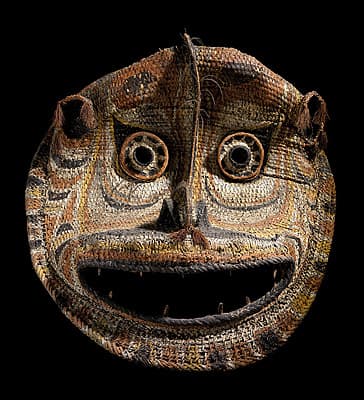
Papua New Guinea, East Sepik Province, Tambanum village
Gable mask Mid 20th century prior to 1954 cane, sago leaf fibre, pigment , cane, sago leaf fibre, ochres, cassowary feathers124.0 (h) x 100.0 (w) x 50.0 (d) cm National Gallery of Australia, Canberra NGA 2008.153 Purchased 2008
Large basketry masks like this gable mask were placed high above the entrance of ngeko ceremonial houses. Intended to be seen from a distance, their placement at the exterior apex of the large and imposing ceremonial house would loom downwards over the nearby dance ground.
This mask is expertly woven, painted and decorated. Around the eyes and along the curving ridge of the nose (dama) are cassowary feathers. The eyes hold a piercing glare and the large open mouth has spikes for teeth (nimbi). Both give an impression of aggressiveness. Ceremonial houses are considered to be the living embodiment of the founding ancestors.
The ridgepole and elaborately carved support posts are connected to the male spiritual essences, or life force. The external features of the house have female spiritual essence, with the gable mask representing the face of the original female ancestor whose body is the building itself. Each ceremonial house has a name, being a living entity, and is also believed to eventually die as dilapidation from disrepair sets in over time.
Large basketry masks like this gable mask were placed high above the entrance of ngeko ceremonial houses. Intended to be seen from a distance, their placement at the exterior apex of the large and imposing ceremonial house would loom downwards over the nearby dance ground.
This mask is expertly woven, painted and decorated. Around the eyes and along the curving ridge of the nose (dama) are cassowary feathers. The eyes hold a piercing glare and the large open mouth has spikes for teeth (nimbi). Both give an impression of aggressiveness. Ceremonial houses are considered to be the living embodiment of the founding ancestors.
The ridgepole and elaborately carved support posts are connected to the male spiritual essences, or life force. The external features of the house have female spiritual essence, with the gable mask representing the face of the original female ancestor whose body is the building itself. Each ceremonial house has a name, being a living entity, and is also believed to eventually die as dilapidation from disrepair sets in over time.
Large basketry masks like this gable mask were placed high above the entrance of ngeko ceremonial houses. Intended to be seen from a distance, their placement at the exterior apex of the large and imposing ceremonial house would loom downwards over the nearby dance ground.
This mask is expertly woven, painted and decorated. Around the eyes and along the curving ridge of the nose (dama) are cassowary feathers. The eyes hold a piercing glare and the large open mouth has spikes for teeth (nimbi). Both give an impression of aggressiveness. Ceremonial houses are considered to be the living embodiment of the founding ancestors.
The ridgepole and elaborately carved support posts are connected to the male spiritual essences, or life force. The external features of the house have female spiritual essence, with the gable mask representing the face of the original female ancestor whose body is the building itself. Each ceremonial house has a name, being a living entity, and is also believed to eventually die as dilapidation from disrepair sets in over time.
